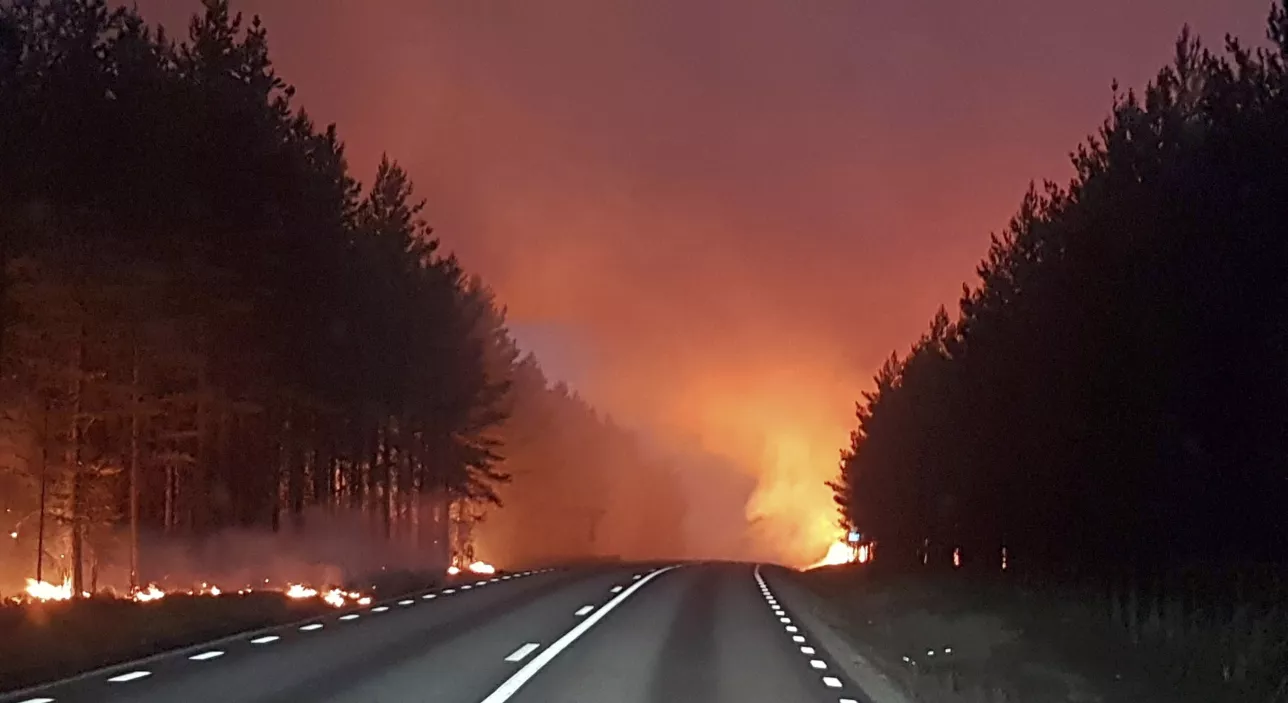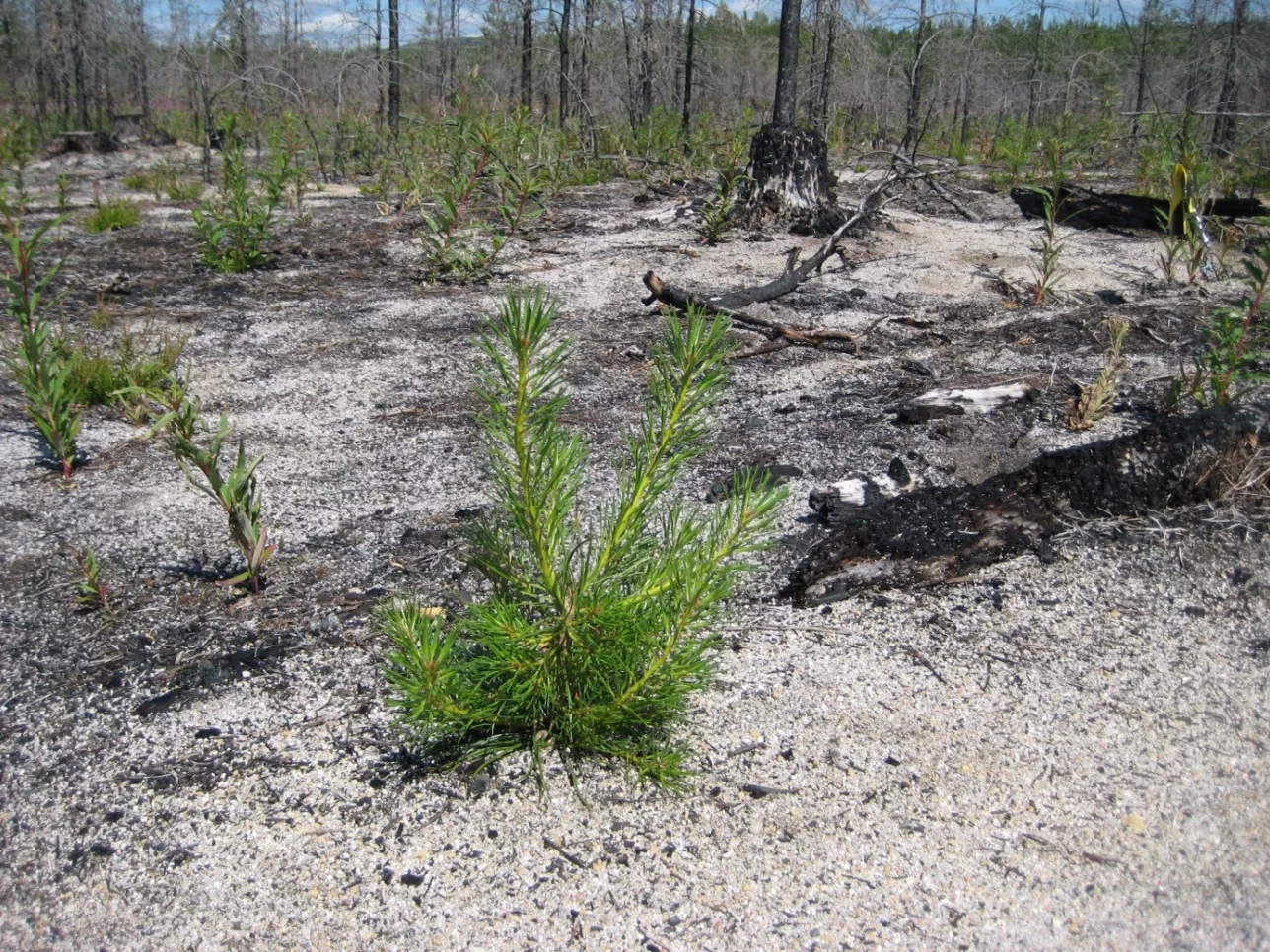Forest Fires Sweden
Forest recovery and management impacts after wildfire - an interdisciplinary perspective
In 2018, Sweden experienced its most severe wildfire season in modern history. Climate warming is predicted to increase the frequency of wildfires, yet knowledge on the impacts of fire and post-fire management decisions in Eurasian forests is scarce. We address these knowledge gaps by examining Sweden’s largest wildfire from 2018. The project links the research of experts in soil microbiology, biogeochemistry, biodiversity and micrometeorology to provide an interdisciplinary picture of the impacts of the fire on the forest ecosystem.

About the project
Wildfires are a natural disturbance in the boreal forest and contribute to its regeneration and biodiversity. In the short term, the most evident effects of forest fires seem negative: they remove vegetation, burn soils, and cause huge economic loss. They also release vast amounts of greenhouse gases into the atmosphere, first when vegetation is burned and later as the dead vegetation decays.
However, in the long term, the emitted carbon dioxide can be stored again as the trees regrow, slowly returning the forest to a carbon sink. Studying forest recovery after wildfire is vital for understanding the net impact of the wildfire on the forest ecosystem and its carbon balance.
The record-breaking hot and dry summer of 2018 resulted in Sweden’s most extreme wildfire season in modern history, but such extremes are likely to become the ‘new normal’ under our warming climate. Little is known about how much greenhouse gases are released during and after a wildfire, about how much of the stored carbon is lost, or about how the energy exchange at the Earth's surface is changed because of a fire.
Even less is known about how different forest management practices after the fire impact the greenhouse gas budget of the recovering forest. This uncertainty impairs climate model predictions and undermines the identification of post-fire management practices that best support Swedish climate targets and the Paris Agreement.
Since September 2018, our international team of experts, in collaboration with the Swedish forest agency, has been monitoring the impacts of the largest wildfire of 2018 in the centre of Sweden. The project focuses on:
- Measuring the impact of the fire and post-fire forest management strategies on the above- and below-ground forest ecosystem and its carbon balance
- Modelling the greenhouse gas budget and climate forcing of the wildfire for use in future climate projections
Publications
Kelly, J., S.H. Doerr, J. Ekroos, T.S. Ibáñez, Md.R. Islam, C. Santín, M. Soares, N. Kljun, 2025. Agricultural and Forest Meteorology, 364, 110454: No recovery of soil respiration four years after fire and post-fire management in a Nordic boreal forest - portal.research.lu.se.
Kljun, N. and Kelly, J. 2024: Forests destroyed by wildfires emit carbon long after the flames die – new study. The Conversation.
Forests destroyed by wildfires emit carbon long after the flames die – new study – theconversation.com
Kelly, J., N. Kljun, Z. Cai, S.H. Doerr, C. D'Onofrio, T. Holst, I. Lehner, A. Lindroth, S. Thapa, P. Vestin, C. Santín, 2024: Wildfire impacts on the carbon budget of a managed Nordic boreal forest. Agricultural and Forest Meteorology, 351, 110016.
Wildfire impacts on the carbon budget of a managed Nordic boreal forest - portal.research.lu.se
Dukat, P., J. Kelly, S.H. Doerr, J. Edvardsson, T.S. Hölttä, I. Lehner, A. Lindroth, C. Santín, N. Kljun, 2024: Boreal forest tree growth and sap flow after a low-severity wildfire. Agricultural and Forest Meteorology, 347, 109899.
Boreal forest tree growth and sap flow after a low-severity wildfire – portal.research.lu.se
Kelly, J., T.S. Ibáñez, C. Santín, S.H. Doerr, M.-C. Nilsson, T. Holst, A. Lindroth, N. Kljun, 2021: Boreal forest soil carbon fluxes one year after a wildfire: effects of burn severity and management. Global Change Biology, 27, 4181-4195.
Boreal forest soil carbon fluxes one year after a wildfire: Effects of burn severity and management – portal.research.lu.se
Presentations
Islam, M.R., L. Nieradzik, A. M. Jönsson, J. Kelly, N. Kljun: Modelling boreal forest recovery after wildfire in a changing climate. Swedish Climate Symposium 2024, Norrköping, Sweden, 15-17 May 2024
Kljun, N., J. Kelly, S.H. Doerr, C. D'Onofrio, T. Holst, I. Lehner, A. Lindroth, C. Santin, 2023: Boreal wildfires: carbon dynamics of Nordic forest recovery, ICOS Nordic 2023 Conference, Bergen, Norway, 21-22 November 2023
Kljun, N., J. Kelly, S.H. Doerr, C. D'Onofrio, T. Holst, A. Lindroth, C. Santín, : 'Boreal wildfires: carbon dynamics of Nordic forest recovery', Invited keynote, International FLUXNET Meeting 2023, Brno, Czech Republic, 11-13 July, 2023
Kelly, J., S.H. Doerr, C. D'Onofrio, T. Holst, I. Lehner, A. Lindroth, C. Santín, M. Soares, N. Kljun: 'The two towers: CO2 fluxes after wildfire in managed Swedish boreal forest stands', EGU23-12028, EGU General Assembly 2023, Vienna, Austria, 23-28 April 2023
Andresen, L.C., T.S. Ibáñez, S. Doerr, C. Santin, J. Kelly, J. Ekroos, J. Rousk, M. Soares, F. Stange, N. Kljun: 'How does wildfire and post-fire management affect the nitrogen soil cycle in a Swedish boreal forest?', Joint European Stable Isotope Users group Meeting, Jesium 2022, Kuopio, Finland, 10-14 October 2022
Kelly, J., S.H. Doerr, T. Ibáñez, A. Lindroth, C. Santín, M. Soares, N. Kljun: 'Impacts of fire severity and post-fire management practices on carbon fluxes in a Swedish boreal forest', ICOS Science Conference 2022, Utrecht, the Netherlends, 13-15 September 2022
Kelly, J., S.H. Doerr, J. Ekroos, T. Ibáñez, C. Santín, M. Soares, N. Kljun: 'Evaluating the effects of fire severity and post-fire management decisions on the carbon balance of a Swedish forest', EGU22-7318, EGU General Assembly 2022, Vienna, Austria, 23–27 May 2022
Kljun, N., L.C. Andresen, S. Doerr, J. Ekroos, J. Holst, T. Holst, T.S. Ibáñez, J. Kelly, A. Lindroth, J. Rousk, C. Santin, M. Soares: '2018 Wildfires in Sweden: Fire Severity and Forest Management Impact on Above - and Belowground Ecosystem Recovery', Swedish Climate Symposium 2022, Norrkoping, Sweden, 16-18 May 2022
Soares, M., J. Kelly, J. Rousk, N. Kljun: 'Microbial growth and soil respiration after a boreal wildfire: impact of fire severity and post-fire management', EGU Galileo conference: Fire impacts at the Earth surface across space and time: perspectives for future fire management, Bad Belzig, Germany, 28 March - 1 April 2022
Kljun, N., L.C. Andresen, S. Doerr, J. Ekroos, J. Holst, T. Holst, T.S. Ibáñez, J. Kelly, A. Lindroth, J. Rousk, C. Santin, M. Soares: '2018 Wildfires in Sweden: Fire Severity and Forest Management Impact on Above - and Belowground Ecosystem Recovery', BECC Annual Meeting: Ecosystem-based climate mitigation and adaptation, Varberg, Sweden, 18-19 November 2021
Kljun, N., 2021: 'Forests on Fire', BECC Grand seminar: The recent IPCC report, extreme weather events and implications for society, online, 16 September 2021
Kelly, J., T. Ibáñez, C. Santín, S. Doerr, M.-C. Nilsson, T. Holst, A. Lindroth, N. Kljun: 'Boreal soil carbon fluxes one year after a forest wildfire: impacts of burn severity and forest management', EGU General Assembly 2021, vEGU21, EGU21-2097, 19–30 April 2021
Project leader
Natascha Kljun
E-mail: natascha [dot] kljun [at] cec [dot] lu [dot] se (natascha[dot]kljun[at]cec[dot]lu[dot]se)
Natascha Kljun in Lund University research portal
Participating researchers
- Louise Rütting, Brandenburg Technological University, DE - b-tu.de
- Stefan H. Doerr, Swansea University, UK - swansea.ac.uk
- Claudio D'Onofrio, Lund University, SE - portal.research.lu.se
- Paulina Dukat, Poznan University, PL - skylark.up.poznan.pl
- Johan Eckdahl, Lund University, SE - portal.research.lu.se
- Johan Ekroos, University of Helsinki, FI - helsinki.fi
- Jutta Holst, Lund University, SE - portal.research.lu.se
- Thomas Holst, Lund University, SE - portal.research.lu.se
- Theresa S. Ibáñez, SLU, SE - slu.se
- Md. Rafikul Islam, Lund University, SE - cec.lu.se
- Julia Kelly, Lund University, SE - cec.lu.se
- Irene Lehner, Lund University, SE - cec.lu.se
- Anders Lindroth, Lund University, SE - portal.research.lu.se
- Lars Nieradzik , Lund University, SE - portal.research.lu.se
- Marie-Charlotte Nilsson, SLU, SE - slu.se
- Johannes Rousk, Lund University, SE - portal.research.lu.se
- Cristina Santín, Universidad de Oviedo, ES - unioviedo.es
- Margarida Soares, Lund University, SE - portal.research.lu.se

Funding
- FORMAS
- The Crafoord Foundation
- BECC
- Skogssällskapet
- Royal Physiographic Society of Lund